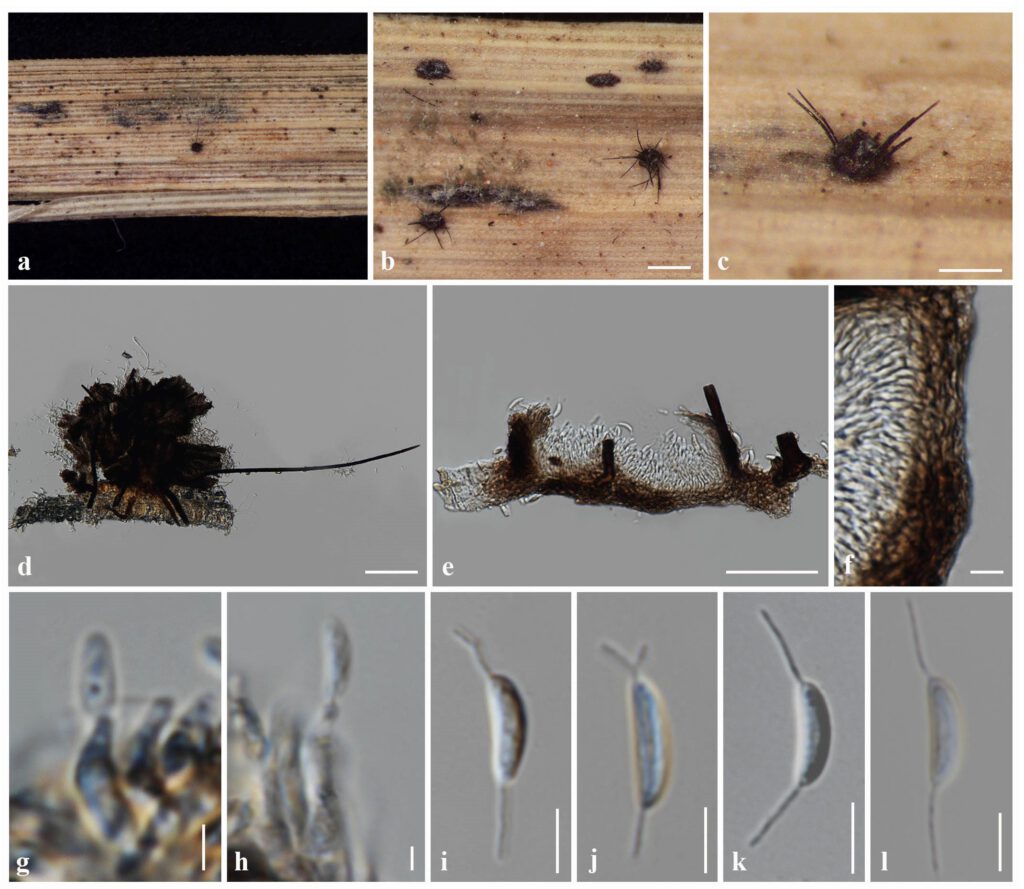Dinemasporium pseudostrigosum
MycoBank number: MB 800164; Index Fungorum number: IF 800164; Facesoffungi number: FoF 07316;
Description
Saprobic on culms of dead grass. Sexual morph: Undetermined. Asexual morph: Coelomycetous. Conidiomata 60–100 × 120–150 µm ( = 80 × 135 μm, n = 15), stromatic, brown to black, superficial, solitary to gregarious, occasionally confluent, pulvinate, oval to rounded in outline, cupulate, with incurved margins, unilocular, setose. Conidiomatal setae 200–250 µm long, 3–5 µm wide, arising from the basal stroma, straight or curved, septate, brown but pale at the apex, thick-walled, acute, unbranched. Conidiomatal wall 8–10 µm wide, of textura angularis with cells brown to pale brown, thick-walled. Conidiophores lining the basal stroma, rectangular to cylindrical, smooth, pale brown to hyaline, unbranched. Conidiogenous cells 6–11 × 2–3 µm ( = 9 × 2.3 μm, n = 20), phialidic, subcylindrical to lageniform, hyaline, smooth. Conidia 8–10 × 2–3.5 μm ( = 9 × 3 μm, n = 40), hyaline, naviculate to fusiform or ellipsoid, obtuse or slightly acute at the apex, slightly truncate at the base, unicellular, eguttulate or guttulate, smooth, bearing 3–6 µm long, unbranched, single tubular appendage at each end.
Material examined: THAILAND, Chiang Mai Province, Mae Teang District, Mushroom Research Center (M.R.C.), on dead culms of unidentified grass (Poaceae), 24 March 2016, Ishani D. Goonasekara, IGm34, new geographical record, living culture MFLUCC 16-0894; ibid. on dead culms of unidentified grass (Poaceae), 28 March 2016, Ishani D. Goonasekara, IGm38, living culture MFLUCC 16-0896.
Distribution: Germany, Italy, Japan, Thailand (Crous et al. 2012, Hashimoto et al. 2015, Li et al. 2020, Gooansekara et al. 2022)
Sequence data: MFLUCC 16-0894: ITS: OL824834 (ITS5/ITS4); LSU: OL824838 (LROR/LR5) MFLUCC 16-0896: ITS: OL824837 (ITS5/ITS4); LSU: OL824839 (LROR/LR5)
Notes: This taxon was originally described in Crous et al. (2012) from Triticum aestivum in Germany. In the phylogenetic analysis, the two isolates MFLUCC 16-0894 and MFLUCC 16-0896 clustered with Dinemasporium pseudostrigosum isolates (CBS 717.85, CBS 825.91 and MFLU 15-0588) in a strongly supported clade (81% ML, 91%, 0.99 BYPP). Morphologically, our collections resemble Dinemasporium pseudostrigosum (CBS 717.85, CBS 825.91) in having stromatic, brown to black, superficial, unilocular, setose conidiomata, subcylindrical to lageniform conidiogenous cells and naviculate to fusiform or ellipsoid, aseptate, hyaline conidia with tubular appendages at each end (Crous et al. 2012). However, our collection has slightly smaller conidia (8–10 × 2–3.5 μm) than the type species (12–13 × 3 μm) (Crous et al. 2012). Our collection is described herein as a new geographical record of Dinemasporium pseudostrigosum for Thailand.

Fig. Dinemasporium pseudostrigosum (IGm34, new geographical record). a, b. Appearance of conidiomata on host. c. Close-up of conidioma. d. Squash mount of conidioma with setae. e. Section of conidioma. f. Conidiomatal wall. g, h. Conidiogenous cells and developing conidia. i–l. Conidia. Scale bars: d, e = 50 µm, g, h = 2 µm, f, i–l = 5 µm.
